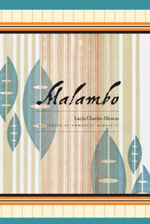

Swan Isle Press, hardcover, 9780974888101
The South American historical fiction that I have read tends to focus on the battles between the European powers for control of the continent. The large populations of indigenous Americans and imported slaves have been conspicuous by their absence, although themes of negritude and African influence are prominent in books from the Caribbean, just to the north. Malambo, the debut novel of Peruvian writer Lucía Charún-Illecas, presents a welcome alternative view of the origin of her home continent. In doing so, she joins a small number of writers, such as Ana Teresa Torres and Ana Gloria Moya, in giving a literary voice to South American negritude.
The novel centres on the now-disappeared Lima suburb of Malambo, a place populated by freed slaves and other Africans. It lies across the river from the Spanish and mulatto dominated riches of the capital city. Set in about 1600, slavery is still the norm, and strict racial categories still define social class in the newly formed Spanish viceroyalty of Peru. The main character is Tomasón, an artist and a slave. He is old and dying, effectively free by the indulgence of his master, but still at his beck and call. Tomasón is at a crossroads of cultures: he paints Christian art for the Spanish and mulatto rich in Lima, but an encounter with a dead friend convinces him to also paint the Gods and spirits of Yoruban tradition. In addition, he is friends with Yawar Inka, who steals gold artifacts from Christian churches to melt down for use in Incan burial ceremonies. The artist is therefore at the heart of, and is a metaphor for, the influences that would shape the emerging nation.
The story does not just belong to Tomasón. Charún-Illecas uses the suburb of Malambo to examine the relationships, both social and sexual, between the local landowner de la Piedra and his slave Altagracia, as well as the position of the poor free men, such as the scheming Melgarejo, who is not racially pure enough to join society's elite, and who responds by oppressing its least empowered members. Malambo looks at the interplay of ordinary human relationships with the racial politics of a slave nation, reflecting the growing nexus of peoples that would become the basis of modern Peru.
Although the themes may be more familiar from Caribbean literature, many motifs put Malambo firmly within the tradition of
South American magical realism. Dead people appear with regularity, and some sequences are told with dream-like prose that
blurs the lines between reality and fantasy within the narrative. The profusion of stories creates a book in which there are
both many narratives and none; this does occasionally lead to a sense of frustration at the meandering text, something which
the clunky translation doesn't always help with. However, Malambo challenged my expectations and I finished it with a very
different view of South American history than when I started. It is an impressive debut novel from a promising new literary
voice, and an entertaining alternative history of the birth of a nation.
